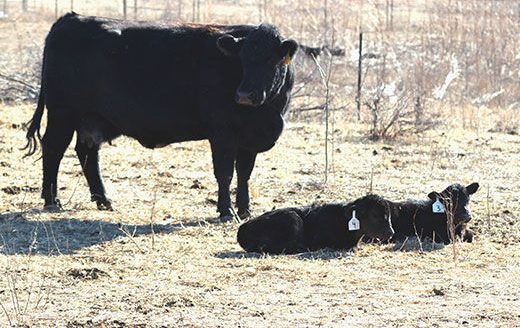As warm weather arrives so does fly problems in cattle operations. Flies not only feed on cattle they can transmit diseases such as pinkeye. Researchers even attribute mastitis problems to horn flies that feed around the udders of heifers while they’re still on the cow.
Horn flies become an economical concern when over 200 flies per animal can be estimated on their sides and back. A horn fly can take a blood meal from cattle 30 or 40 times a day so it’s easy to see how they can cause poor animal performance.A dust bag works for fly control when forced to use it regularly.
Face flies are a great concern to cattle as they can transmit pinkeye as they feed on secretions around the eyes and nostrils. Their numbers seem to peak in late summer. Unlike the horn fly, they do not stay on the animal all the time so control is difficult unless the pesticide can be directly applied to the face.
Stable flies have drawn a good bit of attention more recently. They do feed on blood form the animal and tend to congregate along the underline and front legs of cattle. Their breeding ground is around decaying organic matter such as wet hay. For that reason they’re often found near bale rings that have not been cleaned up.
There are numerous ways to control flies, especially the horn fly. The face and stable varieties can be more of a challenge to control. For horn flies, insecticidal ear tags have proven effective when you manage them properly. That includes not applying them too early in the season, no using the same chemical every year and leaving the tag in all year. There are new compounds this year that may help with the resistance issue.Face Flies can cause eye irritations.
The tags mostly are recommended for two per cow or stocker. Nursing calves are usually not tagged. Plan to remove the tags as soon as you notice fly control declining.
Sprays or fogging periodically is still popular as you gather the animals into a group for feeding cubes or mineral. Of course the use of oral larvacides can help hold fly numbers down if there’s consistent consumption.
Year-in and year-out one of the most economical control methods is the backrubber or dust bags placed where cattle use it daily. Placing the device in a regular traffic area such as water, mineral and shade is preferred. It’s also important to keep it charged and use a chemical that flies have not developed resistance to.Face Flies on a heifer.
Research continues to look at individual genetic differences in cattle’s resistance to flies. Pay attention in your own herds and chances are you’ll notice some cattle with large numbers of horn flies on their backs. In contrast, you’ll find some animals that have few flies on them.
As you develop your plan of attack on the various fly populations the important thing is to, do something, start early in the season and have a backup plan if one approach isn’t working.


